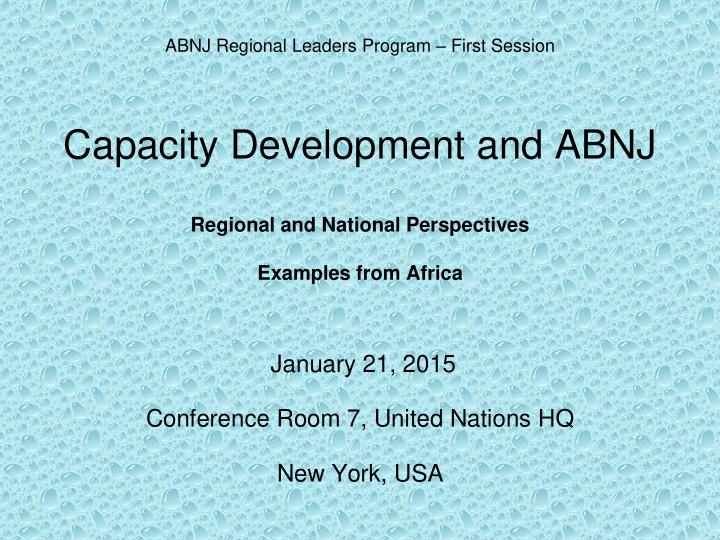



ABNJ Regional Leaders Program – First Session Capacity Development and ABNJ Regional and National Perspectives Examples from Africa January 21, 2015 Conference Room 7, United Nations HQ New York, USA
Outline From regional to national • 1. Regional perspective on ABNJ - Africa Group’s position - African Regional Seas - Challenges • 2. Sub-regional initiatives and programs - Awareness raising_ - Capacity building needs • 3. Successful case study - Ocean Economy - Joint management strategy
1. Regional perspective on ABNJ (i) AIMS 2050 - ABNJs Silent - Reference to Africa Maritime Domaine (AMD) - AMD has vast potential for wealth creation.
1. Regional perspective on ABNJ (C’d) (ii) Africa Group’s position Africa Group statement at the 8th Ad-Hoc Open-ended Informal Working Group on areas beyond national jurisdiction (i.e: common heritage of mankind principle + technical capabilities + transfer of marine technology
1. Regional perspective on ABNJ (C’d) (iii) African Regional Seas • 4 Conventions and relevant protocols (Abidjan, Barcelona, Nairobi, PERSGA) • Abidjan Convention COP11 Decision - CP. 11/10. Conservation and Sustainable use of the Marine Biodiversity of the Areas Located beyond National Jurisdictions
1. Regional perspective on ABNJ (C’d) (iv) Challenges ahead • Activities on ABNJ impact EEZ and vice versa • No coherent regional legal framework • Lack of capacities and financial resources • Lack of ocean governance mechanisms • Lack of compliance and enforcement (to monitor, control and surveillance the activities)
2. Sub-regional Organisations/Initiatives (i) Awareness raising (ii) Capacity Building Needs • Nairobi Convention and Protocols • EA Regional Seas Program • WIOMSA • IOTC • IOC • SWIOFC • CORDIO • SIODFA • AFRICAN UNION • COMESA • SADC • EAC
2. Sub-regional Programs/Projects
ASCLME project Comoros Madagascar Tanzania Baseline assessment of Kenya Somalia the ASCLME was done in order to: Seychelles • Fill information gaps Reunion (France) • To ascertain the role of Mauritius external forcing functions (such as the Mascarene Mozambique Plateau and the Southern Eastern Coast of Equatorial Current) South Africa
GEF- WIOMHP Creation of a Marine Highway (especially in the Mozambique Channel) to ensure safe passage of ships by preventing oil spill pollution control. Empowerment of the participating countries to be in a state of preparedness in conformity with the IMO Conventions OPRC 90 and HNS 2000.
2. OTHERS PROJECTS • SWIOFP • WIOLaB • EAF- NANSEN • SEA MOUNT • ACEP • ReCoMap • TRANSMAP • PUMPSEA • NAGISA • North Mozambique Channel - WHS
2. Capacity Building Needs Research – A need for comprehensive research to explore all biodiversity and resources in the region and do ecosystem valuation. Monitoring – In-terms of human, methods and tools for the purpose of keeping proper track records of changes and therefore forms the basis for proper and informed decisions. Observer programmes for fisheries and biodiversity Enforcement and compliance
3. Successful case study Ocean/Blue Economy – Mauritius & Seychelles case 1. Seabed exploration for hydrocarbon and minerals 2. Fishing, seafood processing and aquaculture 3. Deep ocean water applications (MRU) 4. Marine services 5. Seaport-related activities 6. Marine renewable energies 7. Marine Biotechnology 8. Ocean knowledge cluster
Sustainable development of the Ocean Economy Core asset of the Ocean Economy: Protection of the maritime health and the preservation of Mauritian biological diversity Rio+20 Declaration on the importance of the conservation and the sustainable use of the oceans and The 2005 Mauritius seas Strategy for the further implementation of the Barbados Plan of Action The Maurice Ile Durable & Seychelles Dev Stg Policy Strategy and Action Plan for sustainably developing the Ocean Economy
16
Signed 13 March 2012 Treaty Concerning the Joint Management of the Continental Shelf in the Mascarene Plateau Region PART 1: PRELIMINARY PART 6: EMPLOYMENT, HEALTH AND SAFETY AND Article 1: Definitions APPLICATION OF DOMESTIC LAWS Article 2: Treaty without Prejudice Article 14: Employment Article 15: Health and Safety for Workers PART 2: THE JOINT MANAGEMENT AREA Article 16: Criminal Jurisdiction Article 3: Joint Management Area Article 17: Customs, Migration and Quarantine Article 18: Safety, Operating Standards and Crewing of PART 3: INSTITUTIONAL AND REGULATORY Resource Industry Vessels ARRANGEMENTS Article 4: Regulatory Bodies PART 7: SURVEILLANCE, SECURITY AND RESCUE A three-tiered joint administrative structure Article 19: Surveillance and Security Measures Ministerial Council: Article 20: Search and Rescue Joint Commission: Designated Authority: PART 8: SETTLEMENT OF DISPUTES, DURATION AND Article 5: Sharing of Revenue ENTRY INTO FORCE Article 6: Taxation Code Article 21: Settlement of Disputes Article 7: Application of Domestic Law Article 22: Amendment Article 8: Natural Resource Codes Article 23: Duration of the Treaty Article 24: Entry into Force PART 4: PIPELINES AND UNITISATION Article 9: Pipelines Article 10: Unitisation Article 11: Surveys Article 12: Protection of the Seabed Marine Environment Article 13: Biological Surveys and Bioprospecting
ABNJ above CONTINENTAL shelf 1. Connectivity Water Column 2. Sedentary above species Continental Shelf 3. Bottom fishing 18
CONCLUSION • 1. Awareness and capacity development on ABNJ challenges for Africa continent • 2. Encourage the MCS activities in the EEZ/ABNJ • 3. Established Management framework for CS • 4. Marine Spatial Planning capacity • 5. Proper ocean governance mechanisms for Africa
Abidjan Convention THANK YOU!
Recommend
More recommend